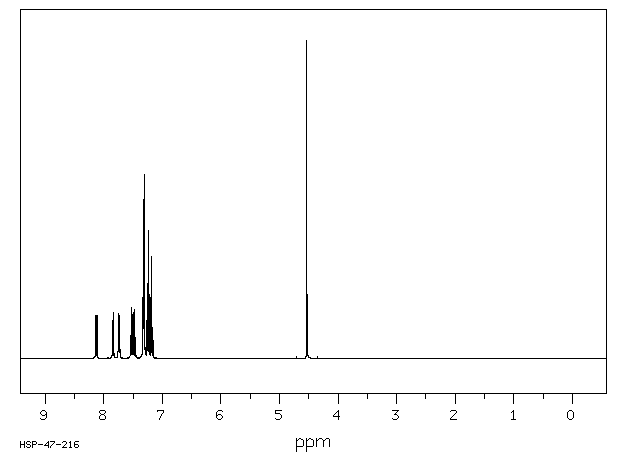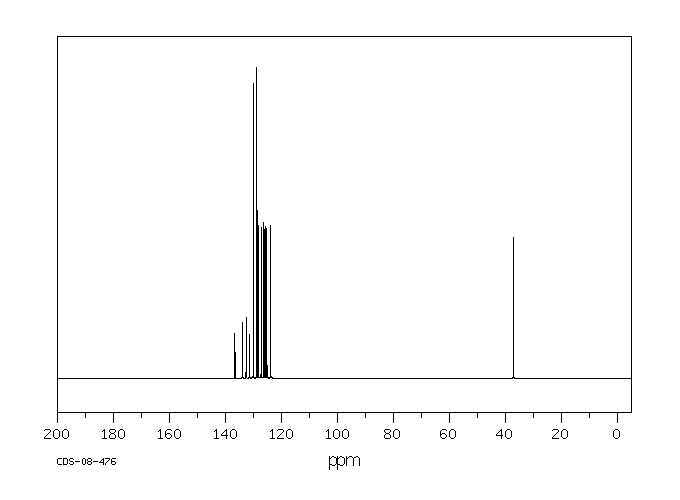(naphthalen-1-ylmethyl)(phenyl)sulfane | 58948-52-0
中文名称
——
中文别名
——
英文名称
(naphthalen-1-ylmethyl)(phenyl)sulfane
英文别名
1-(phenylthiomethyl)naphthalene;α-naphthylmethyl phenyl sulfide;1-[(Phenylsulfanyl)methyl]naphthalene;1-(phenylsulfanylmethyl)naphthalene
CAS
58948-52-0
化学式
C17H14S
mdl
——
分子量
250.364
InChiKey
QSISGDJTBJYWPZ-UHFFFAOYSA-N
BEILSTEIN
——
EINECS
——
-
物化性质
-
计算性质
-
ADMET
-
安全信息
-
SDS
-
制备方法与用途
-
上下游信息
-
文献信息
-
表征谱图
-
同类化合物
-
相关功能分类
-
相关结构分类
计算性质
-
辛醇/水分配系数(LogP):5.3
-
重原子数:18
-
可旋转键数:3
-
环数:3.0
-
sp3杂化的碳原子比例:0.06
-
拓扑面积:25.3
-
氢给体数:0
-
氢受体数:1
SDS
上下游信息
-
上游原料
中文名称 英文名称 CAS号 化学式 分子量 —— 1-naphthaldehyde bis(phenylthio)acetal 113451-20-0 C23H18S2 358.528
反应信息
-
作为反应物:描述:参考文献:名称:A Facile Method for the Fluorine Substitution of Phenylthio GroupviaSulfonium Salts Using Cesium Fluoride摘要:单氟化合物通过将苯基硫化物与氟磺酸甲酯和氟化铯在回流的二氯甲烷中顺序处理,能够以良好的产率轻易制备。该反应在温和条件下进行,不会影响共存的溴取代基。DOI:10.1246/cl.1987.1985
-
作为产物:描述:N,N-二甲基-1-(萘-1-基)甲胺 在 caesium carbonate 、 乙腈 作用下, 以 乙醚 为溶剂, 反应 12.0h, 生成 (naphthalen-1-ylmethyl)(phenyl)sulfane参考文献:名称:苄基三甲基铵盐与二(杂)芳基二硫化物和二硒化物的无过渡金属偶联反应摘要:开发了一种新的方案,以从(手性)苄基三甲基铵盐和二(杂)芳基二硫化物或二硒化物合成(对映体富集)硫醚和硒醚。弱碱的存在促进了这些合成,并且不需要使用任何过渡金属,从而使目标产物的收率达到了良好或优异(72-94%)。使用由对映体富集的胺合成的季铵盐可生成高度对映纯的苄基硫醚和硒醚(94-99%ee),其构型与对映体富集的季铵盐相反。DOI:10.1039/d0cc05633b
文献信息
-
Ionic liquid/PPh3 promoted cleavage of diphenyl disulfide and diselenide: a straight-forward metal-free one-pot route to the synthesis of unsymmetrical sulfides and selenides作者:Subhash Banerjee、Laksmikanta Adak、Brindaban C. RanuDOI:10.1016/j.tetlet.2012.02.047日期:2012.4A metal-free cleavage of diphenyl disulfide and diphenyl diselenide has been achieved using ionic liquid/triphenyl phosphine (PPh3) and a convenient protocol for the one-pot synthesis of unsymmetrical sulfides and selenides by condensing ‘in situ’ generated thiolate or selenate anion with alkyl halides has been developed. In addition, 1,4-conjugate addition of the generated thiolate anions to activated
-
A comparative study of Cu(II)-assisted vs Cu(II)-free chalcogenation on benzyl and 2°/3°-cycloalkyl moieties作者:SANTOSH K SAHOODOI:10.1007/s12039-015-0981-0日期:2015.12A relative synthetic strategy toward intermolecular oxidative C −Chalcogen bond formation of alkanes has been illustrated using both Cu(II) assisted vs Cu(II) free conditions. This led to construction of a comparative study of hydrocarbon benzylic and 2∘/ 3∘-cycloalkyl moieties bond sulfenylation and selenation protocol by the chalcogen sources, particularly sulfur and selenium, respectively. In addition, this protocol disclosed the auspicious formation of sp3 C−S coupling products over leading the sp3 C−N coupling products by using 2-mercaptobenzothiazole (MBT) substrates.
-
一种新型离子型双核席夫碱钛配合物的制备 及其应用申请人:山西医科大学公开号:CN107722049B公开(公告)日:2020-06-30本发明提供了一种一种新型离子型双核席夫碱钛配合物的制备及其应用于催化锌粉还原二硫醚或硒醚制备硫(硒)代酸酯和不对称硫(硒)醚的合成方法。所述的配合物是阳离子型双核席夫碱钛配合物,其中钛原子由氧原子侨连,并与席夫碱配体和一个水分子配位,整个席夫碱钛阳离子部分与阴离子部分形成离子键。以上述双核席夫碱钛配合物作为催化剂,锌粉为还原剂,可还原断裂二硫(硒)醚,进一步分别与酸酐、α‑溴代羰基化合物、溴代烷反应制备硫(硒)代酸酯和不对称硫(硒)醚。本方法克服传统路易斯酸卤化物易潮解,使用无水溶剂,条件苛刻等不足,提供了一种还原二硫醚或硒醚制备硫(硒)代酸酯和不对称硫醚或硒醚的有效路径,具有产率高,操作简便等优点。
-
Iodine-Mediated Thioetherification of Alcohols with Disulfides or NaSH under Microwave Irradiation作者:Bolun Hu、Huanan Hu、Leilei Sun、Riyuan TangDOI:10.1002/cjoc.201200723日期:2012.10An efficient and novel method for the thioetherification of an alcohol with disulfides or NaSH under microwave irradiation is presented. In the presence of iodine, a variety of alcohols were smoothly S‐alkylated with disulfides or NaSH to give the corresponding thioethers in moderate to excellent yields.
-
Transition-metal-free decarboxylative thiolation of stable aliphatic carboxylates作者:Wei-Long Xing、De-Guang Liu、Ming-Chen FuDOI:10.1039/d1ra00063b日期:——transition-metal-free decarboxylative thiolation protocol is reported in which primary, secondary, tertiary (hetero)aryl acetates and α-CN substituted acetates undergo the decarboxylative thiolation smoothly, to deliver a variety of functionalized aryl alkyl sulfides in moderate to excellent yields. Aryl diselenides are also amenable substrates for construction of C–Se bonds under the simple and mild reaction
表征谱图
-
氢谱1HNMR
-
质谱MS
-
碳谱13CNMR
-
红外IR
-
拉曼Raman
-
峰位数据
-
峰位匹配
-
表征信息
同类化合物
(S)-溴烯醇内酯
(R)-3,3''-双([[1,1''-联苯]-4-基)-[1,1''-联萘]-2,2''-二醇
(3S,3aR)-2-(3-氯-4-氰基苯基)-3-环戊基-3,3a,4,5-四氢-2H-苯并[g]吲唑-7-羧酸
(3R,3’’R,4S,4’’S,11bS,11’’bS)-(+)-4,4’’-二叔丁基-4,4’’,5,5’’-四氢-3,3’’-联-3H-二萘酚[2,1-c:1’’,2’’-e]膦(S)-BINAPINE
(11bS)-2,6-双(3,5-二甲基苯基)-4-羟基-4-氧化物-萘并[2,1-d:1'',2''-f][1,3,2]二氧磷
(11bS)-2,6-双(3,5-二氯苯基)-4羟基-4-氧-二萘并[2,1-d:1'',2''-f][1,3,2]二氧磷杂七环
(11bR)-2,6-双[3,5-双(1,1-二甲基乙基)苯基]-4-羟基-4-氧化物-二萘并[2,1-d:1'',2''-f][1,3,2]二氧杂磷平
黄胺酸
马兜铃对酮
马休黄钠盐一水合物
马休黄
食品黄6号
食品红40铝盐色淀
飞龙掌血香豆醌
颜料黄101
颜料红70
颜料红63
颜料红53:3
颜料红5
颜料红48单钠盐
颜料红48:2
颜料红4
颜料红261
颜料红258
颜料红220
颜料红22
颜料红214
颜料红2
颜料红19
颜料红185
颜料红184
颜料红170
颜料红148
颜料红147
颜料红146
颜料红119
颜料红114
颜料红 9
颜料红 21
颜料橙7
颜料橙46
颜料橙38
颜料橙3
颜料橙22
颜料橙2
颜料橙17
颜料橙 5
颜料棕1
顺式-阿托伐醌-d5
雄甾烷-3,17-二酮








